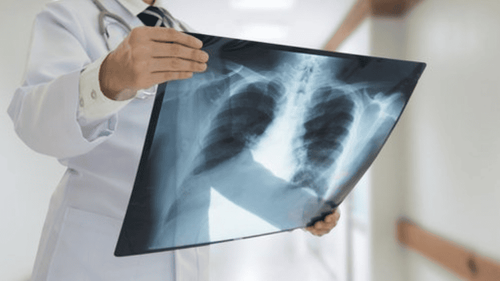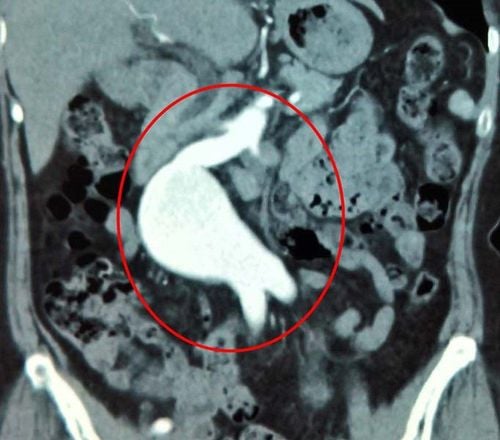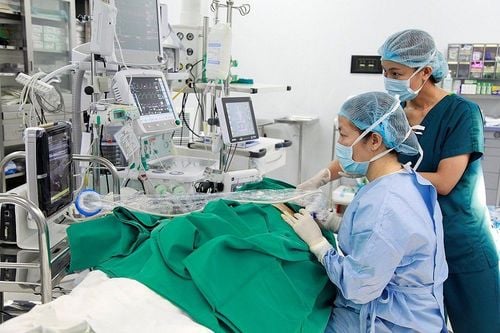This is an automatically translated article.
Aortic arch atrophy is a very rare congenital condition, belonging to the group of congenital heart diseases, with a very high risk of death if not detected and treated early. The pathology of the aortic arch malformation makes the patient fall into heart failure and the patient's ability to live to adulthood is very low. One of the most commonly used treatment methods for this pathology today is aortic surgery.
1. Aortic arch atrophy
Aortic arch atrophy belongs to the group of aortic arch malformations is one of the rare congenital heart diseases, with an incidence of about 3 in 1 million children born with this disease. This is an extremely dangerous disease because if not treated quickly, the patient will develop heart failure, the possibility of death is very high, even some babies who have just been born 4 days have died because of this disease. this medical condition. Some symptoms to confirm the diagnosis of aortic arch malformation are signs of heart failure, a difference between the blood pressure readings in the arms and the blood pressure readings in the legs, symptoms of heart failure. disorders of the respiratory system... In some cases, the adult patient may have accompanying diseases such as ventricular septal defect, damage to the heart valve... In which, the condition has ventricular septal disease. comorbidities usually account for a rate of about 0.07/1000 live births, accounting for 1% of rare congenital heart diseases. Some typical symptoms of this condition include cyanosis, progressive cyanosis, pulmonary edema, congestive heart failure...
To treat aortic arch atrophy, bridging surgery is required. Connecting outside the body's natural anatomical structure for the purpose of making blood flow in the aorta return to a normal level, meeting the body's needs.
2. Aortic surgery

Phẫu thuật động mạch chủ chống chỉ định với bệnh nhân bị suy tim ở mức độ nặng
Aortic surgery is the most effective treatment for aortic arch atrophy as well as aortic arch malformation, but this method also has some relative contraindications that need to be kept in mind such as: following:
The patient has a stable pulmonary hypertension. Patients with heart failure and liver failure, severe kidney failure. The patient has complex congenital heart conditions. The patient had a progressive infection. Before performing surgery, it is necessary to ensure a number of steps in the process of patient preparation as well as surgery as follows:
Inform the family and patient about the aortic surgery that is about to be performed, Family members and patients confirm and sign the consent form for surgery. 1 day before surgery, the patient was cleaned, bathed twice with a solution of water mixed with Betadine, ensuring the body was clean before surgery. Before surgery, use Betadine soap to brush on the patient's chest area, then put an antiseptic solution on the surgical site. Aortic surgery to treat aortic arch malformation is performed according to the following techniques:
Place the patient in the supine position, or in some cases, let the patient lie on the left side for a while. 45° angle General anesthesia by endotracheal method deflates left lung. Open the patient's thorax by making a midsternal incision, the upper lateral line in the IV-V intercostal space Perform anticoagulation of the patient's whole body with Heparin. Set up and connect the patient's circulatory system and the cardiopulmonary machine to run the circulatory system outside the patient's body. Proceed to create an anastomosis between the end of the artificial vessel and the patient's inferior aorta. Perform superior bypass to the superior aorta. Perform unilateral clamping of the superior aorta, taking care not to stop the patient's heart when performing this maneuver. In some cases, it is possible to clamp the entire superior aorta and use a syringe to administer a solution that paralyzes the heart and the root of the aorta for the purpose of stopping the heart. Create an anastomosis between the lateral end of the artificial aortic bridge and the patient's superior aorta. Conduct observation and rehabilitation, and treat other heart injuries such as heart problems, ventricular septal defect, or atrial septal defect. Remove the aortic clamp clamped in the previous steps and perform the resuscitation technique, reactivating the heart. Close the skin incision in the full order of layers such as fascia, muscle and skin according to the patient's anatomical sequence. After performing aortic surgery, the treating doctor as well as the medical staff need to observe and monitor a number of complications on the patient, from which to take timely measures as follows:

Bệnh nhân được hồi sức sau mổ thì cần được chụp phim phổi để theo dõi
Monitor the patient's vitals including pulse, breathing rate, blood pressure, temperature. When the patient is resuscitated after surgery, it is necessary to take a chest radiograph for monitoring. Watch out for some early complications such as pericardial bleeding, hemothorax, or even pneumothorax. If the patient has the above conditions, it is necessary to diagnose the extent of the disease for medical treatment according to the appropriate regimen for each patient, possibly requiring pleural drainage or performing surgery again. Monitor the status of the incision such as swelling, edema, abnormal discharge, bleeding or not. If the patient has a collapsed lung after surgery, it is necessary to bronchoscopy to aspirate sputum or re-operate. Patients with heart failure complications need immediate cardiac support and resuscitation. For post-operative infection, blood culture and antibiogram should be done for antibiotic treatment. Some other complications such as residual stenosis, need medical treatment and dilation or surgery again. Some cases of laryngeal or phrenic nerve damage Aortic arch atrophy or aortic arch malformations, although accounting for a very small percentage, drugs for congenital heart disease are rare but should not be ignored. and needs to be found early for treatment because it affects the patient's life in a very short time. Once the disease has been diagnosed, it is necessary to perform aortic surgery and monitor complications after surgery so that the patient can recover as soon as possible.
To protect heart health in general and detect early signs of myocardial infarction and stroke, customers can sign up for Cardiovascular Screening Package - Basic Cardiovascular Examination of Vinmec International General Hospital . The examination package helps to detect cardiovascular problems at the earliest through tests and modern imaging methods. The package is for all ages, genders and is especially essential for people with risk factors for cardiovascular disease.
Customers can directly go to Vinmec Health system nationwide to visit or contact the hotline here for support.
Recommended video:
Heart failure - the ultimate destination of cardiovascular disease
SEE ALSO:
Mitral valve regurgitation Overcoming shortness of breath and heart palpitations during pregnancy Vinmec pioneered the application of a breakthrough technique to treat heart failure due to coronary artery stenosis













